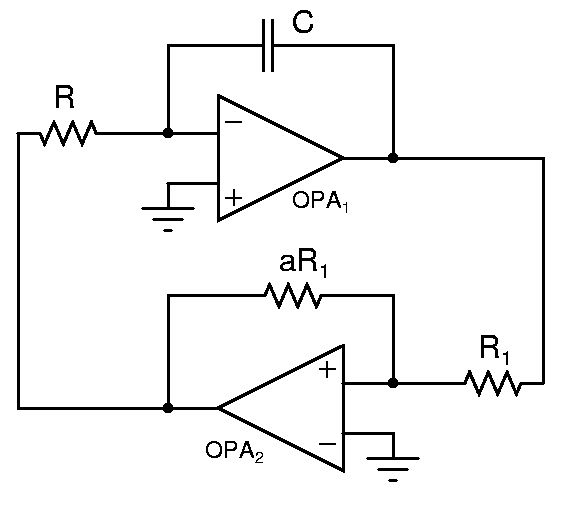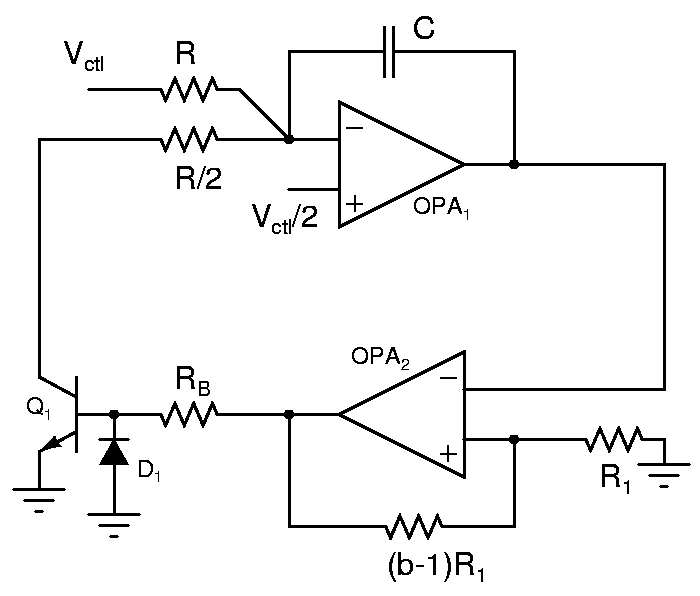Oscillator
- Goals:
- Understand the operation of a schmitt trigger based oscillator
- Design a variable frequency oscillator based on this architecture
- Principle: An oscillator can be constructed using an integrator and a schmitt trigger in a feedback loop such that when the output of the integrator crosses the threshold of the schmitt trigger, the direction of integration is reversed. There are many oscillator topologies based on this principle and in this experiment you'll study one of them.
- Use LF347 quad opamp for this experiment.
- The figure above shows an oscillator using an opamp based integrator(OPA1, R, C) and a non-inverting schmitt trigger(OPA2, R1, aR1). The oscillation frequency depends on the hystereses width of the schmitt trigger and the rate of integration of the oscillator.
- Determine the expression for the oscillation frequency and amplitude at OPA1 output.
- Design an oscillator with a frequency of 10kHz. Choose the hysteresis width to be 10 to 20% of the opamp's peak to peak swing limit. Build and demonstrate the oscillator.
- To make a voltage controlled oscillator, the rate of integration needs to be controlled by a voltage. The above circuit shows a possibility to do that. The schmitt trigger has to be inverting type due to additional inversion introduced by Q1. (Derive Vctl/2 from Vctl using a resistive divider. D1 protects the base-emitter juction of Q1 from breakdown when OPA2 swings negative.)
- Analyze the circuit assuming that Q1 behaves like an ideal switch.
- Design the circuit for a frequency range of 10-15kHz for a control voltage range of 4-6V. Choose the hysteresis width to be 10 to 20% of the opamp's peak to peak swing limit. Build and demonstrate the oscillator. Measure the frequency vs. control voltage characteristics. Does it follow the predicted relationship?
- Change R or C to increase the frequency range to 100-150kHz for the same control voltage range as above. Measure the frequency vs. control voltage characteristics. Does it follow the predicted relationship? Is the fosc vs. Vctl characteristic linear? If not, explain the reasons and predict the deviation. (Hint: Opamp outputs cannot change faster than the slew rate; See the integrator output and the schmitt trigger output simultaneously on an oscilloscope)
- Questions:
- The transistor Q1 is not an ideal switch. It has a saturation voltage of about 0.2V and affects the duty cycle and control linearity. How would you compensate for this? (You cannot assume an exact value for Vsat. It varies with temperature, for instance. You can assume that matched transistors are available.)
- How will you compensate for the last problem described in the previous section?
- Applications: Oscillators are used everywhere in electronic circuitry mainly to generate a reference frequency or time period. Examples are carrier generation in a radio and clock generation in digital circuitry. They are also used for downconversion of signals in a radio, in voltage to frequency converters(a signal is much less susceptible to noise when it is in the form of frequency than in the form of voltage). There is a variety of architectures: “Relaxation” type-as the one above, ring oscillators, LC tank based oscillators, and oscillators based on other resonator types(e.g. quartz). The architecture chosen depends on desired purity(how close it is to an impulse in the frequency domain, or a perfectly periodic waveform in the time domain), stability, tunability etc.

